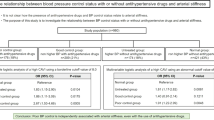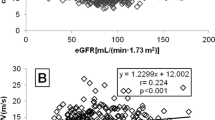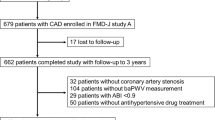Abstract
Aortic stiffness predicts cardiovascular mortality but is limited as a risk marker because it is dependent on blood pressure (BP). A potential solution is provided from the ratio of aortic-to-brachial artery stiffness (ab-ratio), which has been shown to be a BP-independent risk marker among patients with renal dysfunction (RD). We sought to determine the BP independence of the ab-ratio in patients with disease, including RD, and healthy populations. The ab-ratio (aortic/brachial pulse wave velocity) and mean arterial pressure (MAP) were recorded in patients with RD (n = 119, aged 65 ± 7 years), hypertension (n = 140, aged 62 ± 9 years), type 2 diabetes mellitus (n = 77, aged 60 ± 9 years) and healthy subjects (n = 99, aged 51 ± 8 years). Multiple-regression analysis was performed to test the independent association of MAP with the ab-ratio adjusted for age, sex, body mass index, glucose and heart rate. There was no significant relationship between the ab-ratio and MAP in patients with RD (β = 0.08, p = 0.34), hypertension (β = 0.04, p = 0.62) or diabetes (β = 0.22, p = 0.11). However, among healthy subjects the ab-ratio was significantly and independently associated with MAP (β = 0.31, p = 0.003). There was a significant difference in the strength of association between the ab-ratio and MAP between patients with disease and healthy subjects (z > 2.2, p < 0.05 all). Although ab-ratio is purported to be a risk marker that is independent of BP, this was observed only among patient populations, and not among healthy subjects. As a result, the ab-ratio has limited potential as a screening tool for the clinical assessment of arterial stiffness in otherwise healthy individuals.
This is a preview of subscription content, access via your institution
Access options
Subscribe to this journal
Receive 12 digital issues and online access to articles
$119.00 per year
only $9.92 per issue
Buy this article
- Purchase on Springer Link
- Instant access to full article PDF
Prices may be subject to local taxes which are calculated during checkout


Similar content being viewed by others
References
Ben-Shlomo Y, Spears M, Boustred C, May M, Anderson SG, Benjamin EJ, et al. Aortic pulse wave velocity improves cardiovascular event prediction: an individual participant meta-analysis of prospective observational data from 17,635 subjects. J Am Coll Cardiol. 2014;63:636–46.
Vlachopoulos C, Aznaouridis K, Stefanadis C. Prediction of cardiovascular events and all-cause mortality with arterial stiffness a systematic review and meta-analysis. J Am Coll Cardiol. 2010;55:1318–27.
Hansen TW, Staessen JA, Torp-Pedersen C, Rasmussen S, Thijs L, Ibsen H, et al. Prognostic value of aortic pulse wave velocity as index of arterial stiffness in the general population. Circulation. 2006;113:664–70.
Laurent S, Boutouyrie P, Asmar R, Gautier I, Laloux B, Guize L, et al. Aortic stiffness is an independent predictor of all-cause and cardiovascular mortality in hypertensive patients. Hypertension. 2001;37:1236–41.
Cruickshank K, Riste L, Anderson SG, Wright JS, Dunn G, Gosling RG. Aortic pulse-wave velocity and its relationship to mortality in diabetes and glucose intolerance - an integrated index of vascular function? Circulation. 2002;106:2085–90.
Blacher J, Safar ME, Guerin AP, Pannier B, Marchais SJ, London GM. Aortic pulse wave velocity index and mortality in end-stage renal disease. Kidney Int. 2003;63:1852–60.
Mancia G, De Backer G, Dominiczak A, Cifkova R, Fagard R, Germano G, et al. 2007 Guidelines for the management of arterial hypertension: The Task Force for the Management of Arterial Hypertension of the European Society of Hypertension (ESH) and of the European Society of Cardiology (ESC). Eur Heart J. 2007;28:1462–536.
Cecelja M, Chowienczyk P. Dissociation of aortic pulse wave velocity with risk factors for cardiovascular disease other than hypertension: a systematic review. Hypertension. 2009;54:1328–U103.
World Health Organization. Global status report on noncommunicable diseases. Geneva: World Health Organization; 2014.
Reference Values for Arterial Stiffness' Collaboration. Determinants of pulse wave velocity in healthy people and in the presence of cardiovascular risk factors: 'establishing normal and reference values'. Eur Heart J. 2010;31:2338–50.
Fortier C, Sidibe A, Desjardins MP, Marquis K, De Serres SA, Mac-Way F, et al. Aortic-brachial pulse wave velocity ratio: a blood pressure-independent index of vascular aging. Hypertension. 2017;69:96–101.
Fortier C, Mac-Way F, Desmeules S, Marquis K, De Serres SA, Lebel M, et al. Aortic-brachial stiffness mismatch and mortality in dialysis population. Hypertension. 2015;65:378–U278.
Niiranen TJ, Kalesan B, Larson MG, Hamburg NM, Benjamin EJ, Mitchell GF, et al. Aortic-brachial arterial stiffness gradient and cardiovascular risk in the community: the Framingham Heart Study. Hypertension. 2017;69:1022–8.
Schultz MG, Hughes AD, Davies JE, Sharman JE. Associations and clinical relevance of aortic-brachial artery stiffness mismatch, aortic reservoir function, and central pressure augmentation. Am J Physiol Heart Circ Physiol. 2015;309:H1225–H1233.
Schultz MG, Climie RE, Nikolic SB, Ahuja KD, Sharman JE. Persistent elevation of central pulse pressure during postural stress in patients with type 2 diabetes mellitus. J Hum Hypertens. 2013;27:437–44.
Climie RED, Srikanth V, Keith LJ, Davies JE, Sharman JE. Exercise excess pressure and exercise-induced albuminuria in patients with type 2 diabetes mellitus. Am J Physiol Heart Circ Physiol. 2015;308:H1136–H1142.
Nikolic SB, Adams MJ, Otahal P, Edwards LM, Sharman JE. Association of von Willebrand factor blood levels with exercise hypertension. Eur J Appl Physiol. 2015;115:1057–65.
El Assaad MA, Topouchian JA, Darne BM, Asmar RG. Validation of the Omron HEM-907 device for blood pressure measurement. Blood Press Monit. 2002;7:237–41.
Bos WJW, Verrij E, Vincent HH, Westerhof BE, Parati G, van Montfrans GA. How to assess mean blood pressure properly at the brachial artery level. J Hypertens. 2007;25:751–5.
Mitchell GF. Effects of central arterial aging on the structure and function of the peripheral vasculature: implications for end-organ damage. J Appl Physiol. 2008;105:1652–60.
O'Rourke MF, Hashimoto J. Mechanical factors in arterial aging - a clinical perspective. J Am Coll Cardiol. 2007;50:1–13.
McEniery CM, Wilkinson IB, Avolio AP. Age, hypertension and arterial function. Clin Exp Pharmacol Physiol. 2007;34:665–71.
Mourad JJ, Girerd X, Boutouyrie P, Laurent S, Safar M, London G. Increased stiffness of radial artery wall material in end-stage renal disease. Hypertension. 1997;30:1425–30.
Guerin AP, Blacher J, Pannier B, Marchais SJ, Safar ME, London GM. Impact of aortic stiffness attenuation on survival of patients in end-stage renal failure. Circulation. 2001;103:987–92.
Cameron JD, Bulpitt CJ, Pinto ES, Rajkumar C. The aging of elastic and muscular arteries: a comparison of diabetic and nondiabetic subjects. Diabetes Care. 2003;26:2133–8.
Stewart AD, Jiang BY, Millasseau SC, Ritter JM, Chowienczyk PJ. Acute reduction of blood pressure by nitroglycerin does not normalize large artery stiffness in essential hypertension. Hypertension. 2006;48:404–10.
Gaddum NR, Keehn L, Guilcher A, Gomez A, Brett S, Beerbaum P, et al. Altered dependence of aortic pulse wave velocity on transmural pressure in hypertension revealing structural change in the aortic wall. Hypertension. 2015;65:362–9.
Kimoto E, Shoji T, Shinohara K, Inaba M, Okuno Y, Miki T, et al. Preferential stiffening of central over peripheral arteries in type 2 diabetes. Diabetes. 2003;52:448–52.
Townsend RR, Tomiyama H. Arterial stiffness, kidney function, and chronic kidney disease progression. Pulse (Basel). 2013;1:123–30.
Safar M, O'Rourke M. Arterial stiffness in hypertension. Vol. 23. London: Elsevier; 2006.
Briet M, Bozec E, Laurent S, Fassot C, London GM, Jacquot C, et al. Arterial stiffness and enlargement in mild-to-moderate chronic kidney disease. Kidney Int. 2006;69:350–7.
Isnard RN, Pannier BM, Laurent S, London GM, Diebold B, Safar ME. Pulsatile diameter and elastic modulus of the aortic arch in essential hypertension: a noninvasive study. J Am Coll Cardiol. 1989;13:399–405.
McEniery CM, Yasmin, Hall IR, Qasem A, Wilkinson IB, Cockcroft JR, et al. Normal vascular aging: differential effects on wave reflection and aortic pulse wave velocity - The Anglo-Cardiff Collaborative Trial (ACCT). J Am Coll Cardiol. 2005;46:1753–60.
Kithas PA, Supiano MA. Spironolactone and hydrochlorothiazide decrease vascular stiffness and blood pressure in geriatric hypertension. J Am Geriatr Soc. 2010;58:1327–32.
Papaioannou TG, Protogerou AD, Vrachatis D, Konstantonis G, Aissopou E, Argyris A, et al. Mean arterial pressure values calculated using seven different methods and their associations with target organ deterioration in a single-center study of 1878 individuals. Hypertens Res. 2016;39:640–7.
Funding
MKA is supported by an International Postgraduate Research Scholarship from the Menzies Institute for Medical Research. MGS is supported by a National Health and Medical Research Council Early Research Career Fellowship (reference 1104731). DSP is supported by a Broadreach Elite PhD scholarship.
Author information
Authors and Affiliations
Corresponding author
Ethics declarations
Conflict of interest
The authors declare that they have no conflict of interest.
Additional information
Publisher’s note: Springer Nature remains neutral with regard to jurisdictional claims in published maps and institutional affiliations.
Supplementary information
Rights and permissions
About this article
Cite this article
Armstrong, M.K., Schultz, M.G., Picone, D.S. et al. Aortic-to-brachial artery stiffness gradient is not blood pressure independent. J Hum Hypertens 33, 385–392 (2019). https://doi.org/10.1038/s41371-018-0154-y
Received:
Revised:
Accepted:
Published:
Issue Date:
DOI: https://doi.org/10.1038/s41371-018-0154-y



